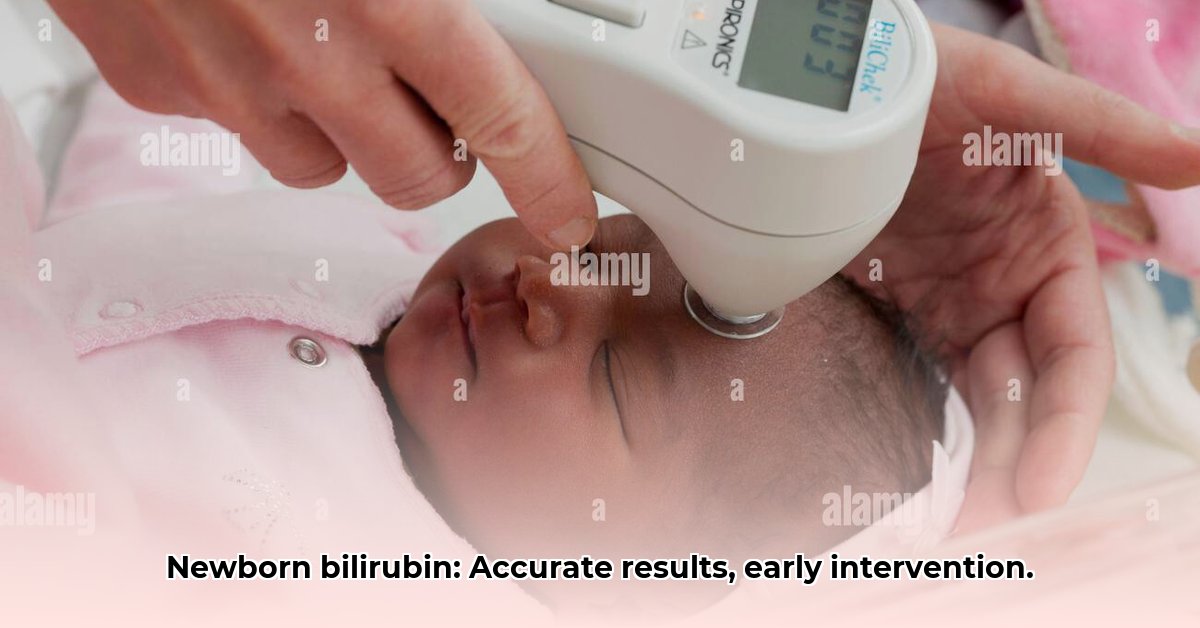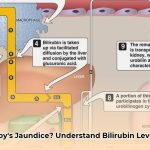Bringing a new baby home is a joyous occasion, but it also comes with a natural sense of responsibility and concern for their well-being. Jaundice, characterized by a yellowish tinge to the skin and eyes, is a common condition in newborns. This guide aims to provide clear, actionable information about newborn bilirubin level tests, helping you understand the causes of jaundice, interpret test results, and confidently navigate your baby’s care in collaboration with their healthcare provider.
Understanding Newborn Jaundice and the Importance of Bilirubin Testing
Jaundice in newborns is often caused by elevated levels of bilirubin, a yellow pigment produced during the normal breakdown of red blood cells. A newborn bilirubin level test is a simple blood test used to measure the amount of bilirubin in your baby’s blood. While mild jaundice is often physiological (normal), high bilirubin levels can pose health risks, making early detection and appropriate management crucial. This test helps healthcare providers determine if your baby needs intervention to lower their bilirubin levels and prevent potential complications.
What is Bilirubin?
Bilirubin is a yellow pigment that’s created when the body breaks down old red blood cells. After production, it travels to the liver, which processes the bilirubin so it can be eliminated from the body in stool.
Why Bilirubin Levels Matter: The Science Behind Jaundice
Bilirubin is essentially a waste product from the natural breakdown of red blood cells. The liver plays a key role in processing and eliminating bilirubin from the body. In newborns, the liver is still developing and may not be fully efficient at this process. This can lead to a buildup of bilirubin in the blood, causing the characteristic yellowish color associated with jaundice. While a certain degree of jaundice is normal, excessively high bilirubin levels require prompt attention to prevent potential neurological damage.
In young babies, unconjugated bilirubin can penetrate the membrane that lies between the brain and the blood (the blood–brain barrier). Unconjugated bilirubin is potentially toxic to neural tissue (brain and spinal cord). Entry of unconjugated bilirubin into the brain can cause both short-term and long-term neurological dysfunction (bilirubin encephalopathy). The term kernicterus is used to denote the clinical features of acute or chronic bilirubin encephalopathy, as well as the yellow staining in the brain associated with the former. The risk of kernicterus is increased in babies with extremely high bilirubin levels. Kernicterus is also known to occur at lower levels of bilirubin in term babies who have risk factors, and in preterm babies.
The Newborn Bilirubin Test: A Simple and Painless Procedure
The newborn bilirubin test is a straightforward and minimally invasive procedure. A small blood sample is typically collected from your baby’s heel via a quick prick. The sample is then sent to a laboratory to measure the bilirubin level, expressed in milligrams per deciliter (mg/dL) or micromoles per liter (mol/L). The entire process is usually quick, and most babies experience minimal discomfort. Healthcare providers may also use a transcutaneous bilirubinometer, a non-invasive device that measures bilirubin levels through the skin using a light. The speed and ease of these tests make them a valuable tool for early detection and management of jaundice.
Interpreting Bilirubin Test Results: Partnering with Your Healthcare Provider
Interpreting bilirubin test results is not as simple as looking at a single number. Your baby’s doctor will assess the result in the context of several factors, including their age (in hours or days), gestational age, weight, feeding habits, and overall health. Other indicators, such as how well your baby is feeding and any other symptoms they may be exhibiting, contribute to a comprehensive assessment. It is crucial to work closely with your healthcare provider to understand the meaning of your baby’s specific bilirubin level and to determine the appropriate course of action, if any.
As a general guide, the American Academy of Pediatrics provides the following thresholds:
| Total serum bilirubin (TSB) level | Age of newborn |
|---|---|
| Above 10 milligrams | Less than 24 hours old |
| Above 15 milligrams | 24 to 48 hours old |
| Above 18 milligrams | 49 to 72 hours old |
| Above 20 milligrams | Older than 72 hours |
It’s important to remember these are guidelines and your doctor will consider your baby’s unique situation when making treatment decisions.
When is a Bilirubin Test Recommended? Identifying High-Risk Infants
While pediatricians routinely check newborns for jaundice during initial check-ups, certain factors may warrant a specific bilirubin test. Premature babies, infants with bruising from delivery, babies with blood type incompatibilities with their mothers (Rh or ABO incompatibility), and those with a family history of jaundice are often at higher risk for developing significant jaundice. In these cases, proactive bilirubin testing is recommended to ensure early detection and timely intervention. Additionally, babies of East Asian descent are more likely to have higher bilirubin levels.
Treatment Options for Newborn Jaundice: Tailoring Care to Your Baby’s Needs
The approach to managing newborn jaundice is tailored to the individual baby’s bilirubin level and overall health. In many cases, frequent feeding, especially breastfeeding, is sufficient to stimulate the baby’s liver and promote bilirubin excretion. Breast-fed infants should have eight to 12 feedings a day for the first several days of life.
Formula-fed infants usually should have 1 to 2 ounces (about 30 to 60 milliliters) of formula every two to three hours for the first week. If bilirubin levels are elevated, phototherapy may be required. Phototherapy involves exposing the baby to special blue lights that help break down bilirubin in the skin. During phototherapy, the baby will wear only a nappy and protective eyewear. This treatment is often administered in a hospital, but it can also be administered at home with specialized equipment under physician supervision. In rare and severe cases, a blood transfusion (exchange transfusion) may be necessary to rapidly lower bilirubin levels and prevent neurological damage.
Weighing the Pros and Cons of Jaundice Treatments: A Collaborative Decision
| Treatment | Pros | Potential Cons or Side Effects |
|---|---|---|
| Frequent Feedings | Simplest approach; Promotes bilirubin elimination; Encourages bonding. | May require lactation support if breastfeeding challenges exist. |
| Phototherapy | Effective bilirubin reduction; Generally well-tolerated. | Mild skin irritation; Rare temporary eye damage (prevented with eye protection). |
| Exchange Transfusion | Rapidly reduces high bilirubin levels in severe cases. | More invasive; inherent risks of blood transfusions; Typically a last resort. |
Treatment options for newborn jaundice are aimed at safely and effectively reducing bilirubin levels. Decisions are made in consultation with your healthcare provider, considering your baby’s specific needs.
Potential Complications of Untreated Jaundice
If jaundice is not properly managed, high levels of bilirubin can lead to serious complications, including:
- Acute bilirubin encephalopathy: This occurs when bilirubin crosses the blood-brain barrier and can cause fever, high-pitched crying, poor feeding, lethargy, and arching of the back.
- Kernicterus: This is a chronic form of bilirubin encephalopathy that can result in permanent brain damage, hearing loss, vision problems, dental issues, and developmental delays.
The Future of Jaundice Management: Ongoing Research and Innovation
Ongoing research continues to refine our understanding of neonatal jaundice and improve management strategies. Current areas of focus include developing more accurate and non-invasive testing methods, exploring novel therapies, and optimizing treatment protocols to minimize potential side effects. Staying informed about the latest advancements in jaundice management empowers you to advocate for the best possible care for your baby.
Key Points for Parents:
- Jaundice is common, but monitoring is important.
- Bilirubin tests are simple and provide valuable information.
- Work closely with your healthcare provider to interpret test results and determine the best course of action.
- Ensure frequent feedings to help your baby eliminate bilirubin.
- Know the signs of worsening jaundice and when to seek immediate medical attention.
A Final Note: Your Questions Are Important
This guide is intended to provide helpful and easy-to-understand information about newborn bilirubin level tests and jaundice. It is essential to remember that this information should not replace the advice of your doctor. If you have any questions or concerns about your baby’s health, do not hesitate to ask your pediatrician. They are your partners in ensuring your little one’s healthy development and well-being. Early detection and appropriate care are key to ensuring your little one is healthy and thriving.
Interpreting Neonatal Jaundice Bilirubin Test Results Across Different Labs
Understanding your baby’s bilirubin level is crucial for managing neonatal jaundice effectively. However, interpreting these results can be challenging because different laboratories may employ varying testing methods and reference ranges. This section will help you navigate these potential discrepancies and confidently discuss your baby’s results with their healthcare provider.
Deciphering Bilirubin and Jaundice: A Refresher
Jaundice, indicated by the yellowish discoloration of a newborn’s skin and eyes, arises from heightened bilirubin levels in the blood. Bilirubin, a natural byproduct of red blood cell breakdown, requires processing by the liver for excretion. Newborns, especially those born prematurely, often have immature liver function, leading to slower bilirubin processing and a potential buildup. While mild jaundice is common and generally harmless, elevated levels necessitate medical intervention to prevent complications.
Understanding How to Interpret Bilirubin Test Results
Serum bilirubin levels are measured through a blood test called Total Serum Bilirubin (TSB). Results are typically reported in milligrams per deciliter (mg/dL) or micromoles per liter (µ
- Water Wheel Electric Generator Provides Free Home Electricity - December 15, 2025
- Choosing the Right Portable Hydro Turbine for Your Needs - December 14, 2025
- Best Portable Hydro Generators for Off-Grid and Outdoor Power - December 13, 2025
















